The blooming of fragrant lilac flowers means that spring is really here! Not everyone knows that these beautiful blossoms are edible and delicious. They don’t last long though, so if you want to make something with them you have to be prepared! One easy way to preserve their flavor is to make this lilac flower infused honey.
Harvesting Lilac Flowers
Since most lilac shrubs are cultivated in yards and gardens, some care needs to be taken when harvesting. If you have your own lilacs then you should know what has or has not been sprayed on them. Don’t use them if they’ve been sprayed with any pesticides or herbicides.
If you are gathering lilacs from a neighbor’s yard, be sure to get permission first and find out if they have been sprayed with anything before using. It’s always nice to offer some of what you are making if you are taking flowers from someone else’s yard.
When you are harvesting lilac flowers, be sure to pick the freshest looking ones that haven’t begun to turn brown yet. Four or five large flower clusters is all that you need for this recipe.
How to Make Lilac Infused Honey
Making an infused honey is so simple and is the perfect way to use edible blossoms like lilacs.
If you don’t have lilacs you can use wild violets or violas, calendula, forsythia, or lavender flowers to make an infused honey.
First cut the lilac flowers off the stem (I find using scissors to be easiest) and into a pint size mason jar. This goes pretty quickly with lilacs as they are quite large and sturdy compared to other smaller and more delicate flowers like elderflowers (see my recipe for elderflower liqueur).
Once the jar is full of lilac flowers, pour in raw honey to completely cover the blossoms.
The honey will settle for a bit and it might take a while for it to make its way to the bottom of the jar. As it does, big bubbles will slowly come up to the surface of the honey.
Let it sit for a bit, then you will probably want to top it off with a bit more honey to cover the blossoms.
After a bit the lilac flowers will inevitably float to the top of the honey, and that’s ok. This is when it is at its prettiest!
As the hours go by the flowers will shrink and become a small mass of flowers at the top of the jar. The photo below shows this process starting to happen, but flower mass will eventually become much thinner and will sit right at the top of the honey.
Cap the jar and let the honey infuse for at least a few days and up to several weeks before using, stirring the flowers up a bit as often as you think of it.
How to Use Lilac Infused Honey
When you are ready to use the honey you can easily scoop out the mass of flowers from the top of the jar with a spoon. You can alternatively leave them in if you’d like as they are edible. It’s up to you!
This infused honey is absolutely delicious and can be used just like regular honey. Try spreading it on toast, biscuits, or scones (or better yet, lilac scones) for a special treat!
The lilac honey will store for a long time, at least several months, in the pantry.
You can make this honey into a lilac syrup by combining it with some lilac flower tea. I usually like to do about 2/3 honey to 1/3 tea when making a syrup like this, but it depends on how thick you want the syrup to be. The syrup will need to be kept in the fridge and will last 1-2 weeks.
Another great idea is to make a lilac honey butter. Simply mix some of the infused honey with softened butter and you have yourself an amazing spread!
Lilac Flower Infused Honey
Ingredients
- 2 cups fresh lilac flowers green stems removed
- 1 1/2 cups raw honey possibly a bit more
Instructions
- Cut the lilac flowers off the stem with scissors and put into a pint size mason jar.
- Once the jar is full of lilac flowers, pour in raw honey to completely cover the blossoms.
- Let the honey settle down into the jar for a bit, then top off the jar with more honey to cover the flowers.
- After a bit the lilac flowers will inevitably float to the top of the honey, and that’s ok.
- Cap the jar and let the honey infuse for at least a few days and up to several weeks before using, stirring the flowers up a bit as often as you think of it.
- When you are ready to use the honey you can easily scoop out the mass of flowers from the top of the jar with a spoon. You can alternatively leave them in if you’d like as they are edible.
Notes
- The infused honey will store for at least several months in a pantry
- Make this honey into a lilac syrup by combining it with some lilac flower tea. I usually like to do about 2/3 honey to 1/3 tea when making a syrup like this, but it depends on how thick you want the syrup to be. The syrup will need to be kept in the fridge and will last 1-2 weeks.
- Make a lilac honey butter by mixing some of the infused honey with softened butter.

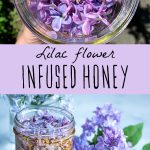
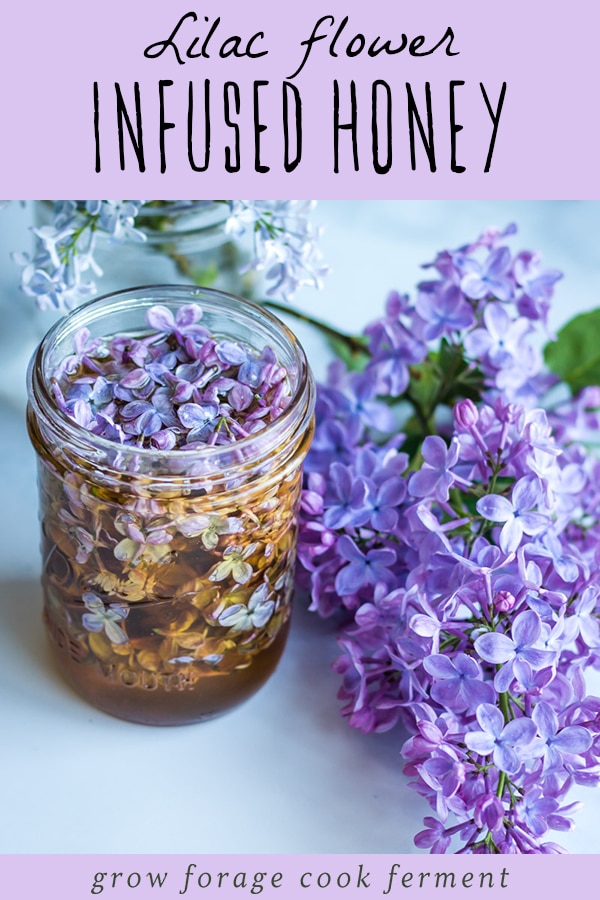
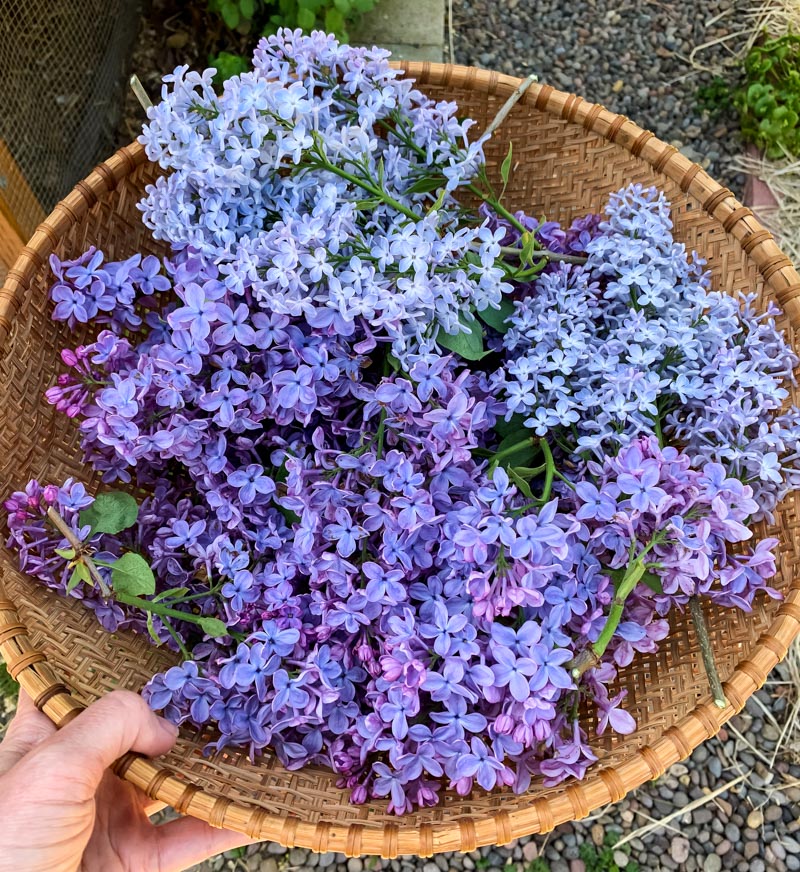
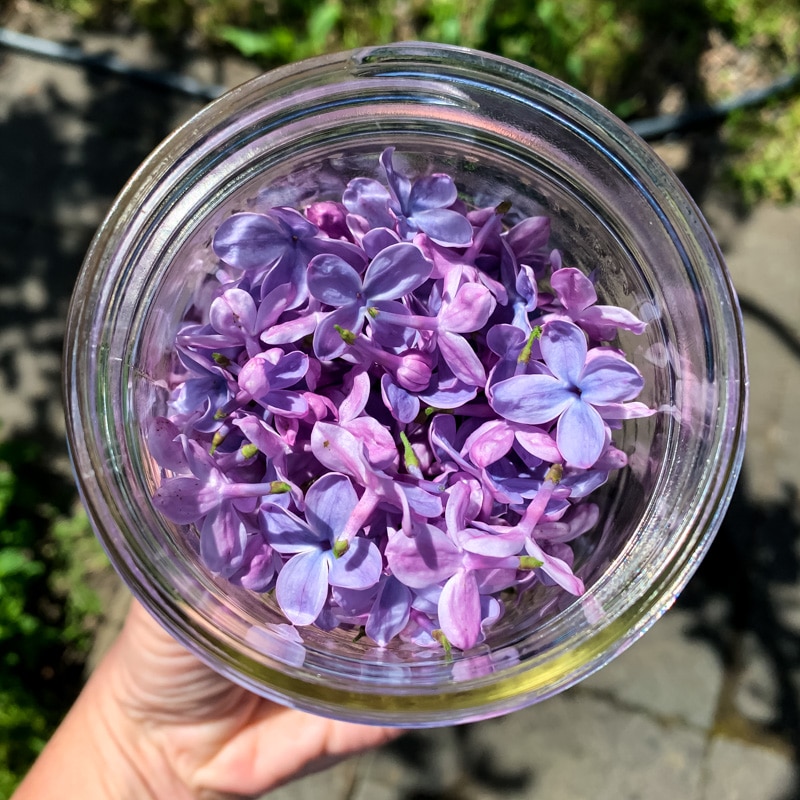
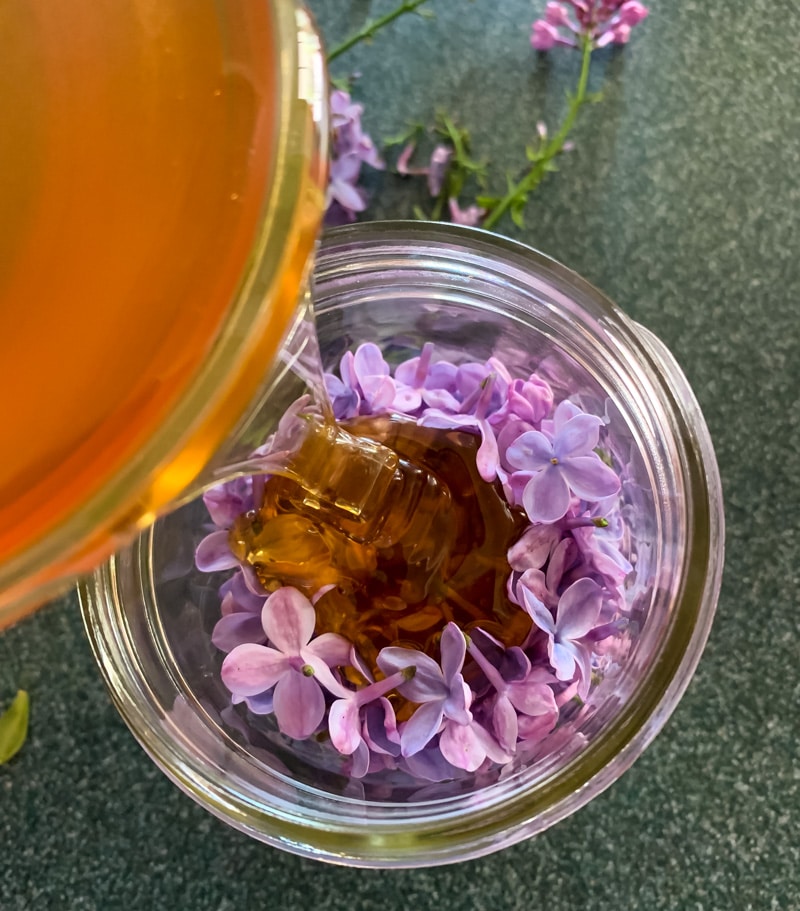

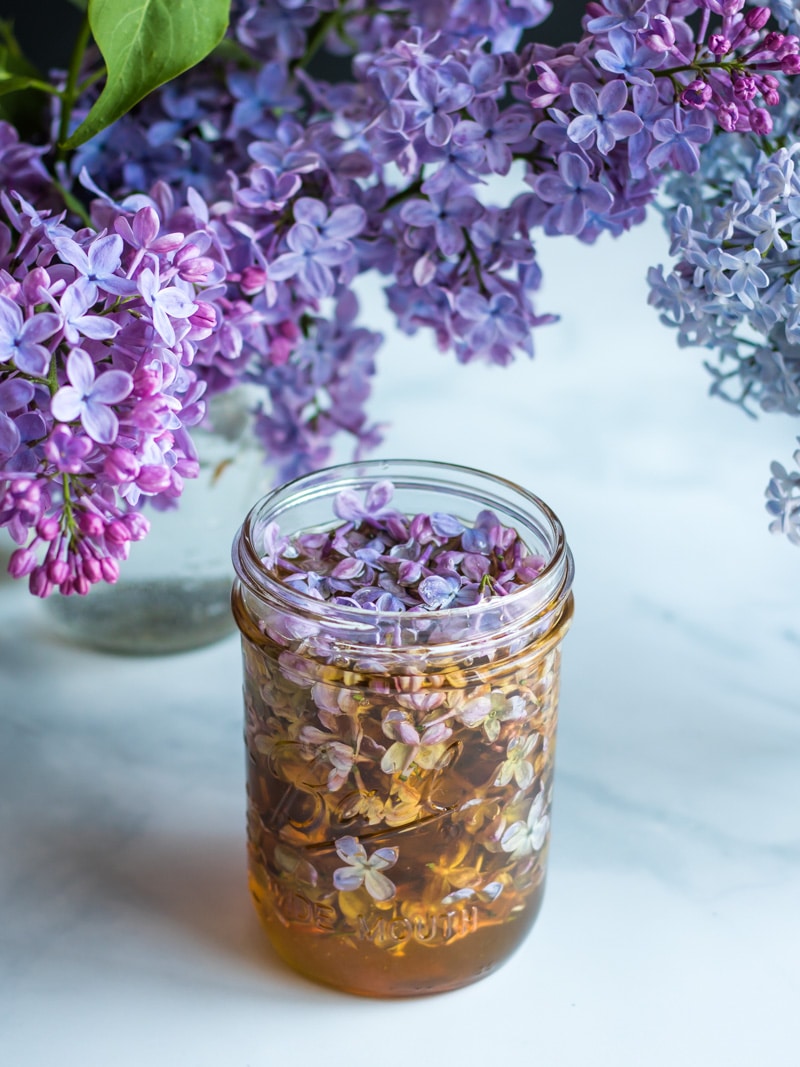
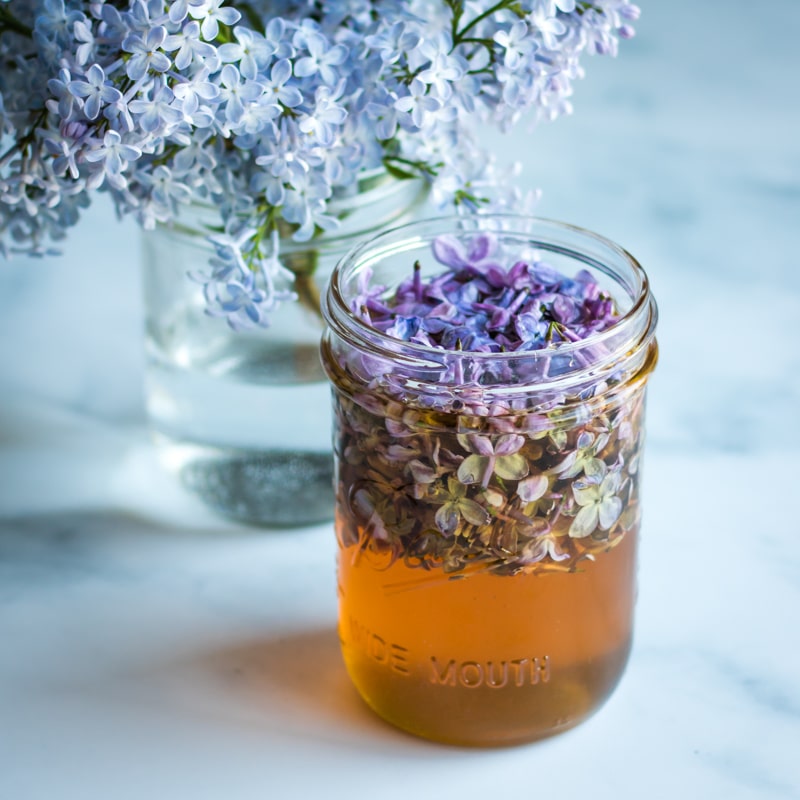
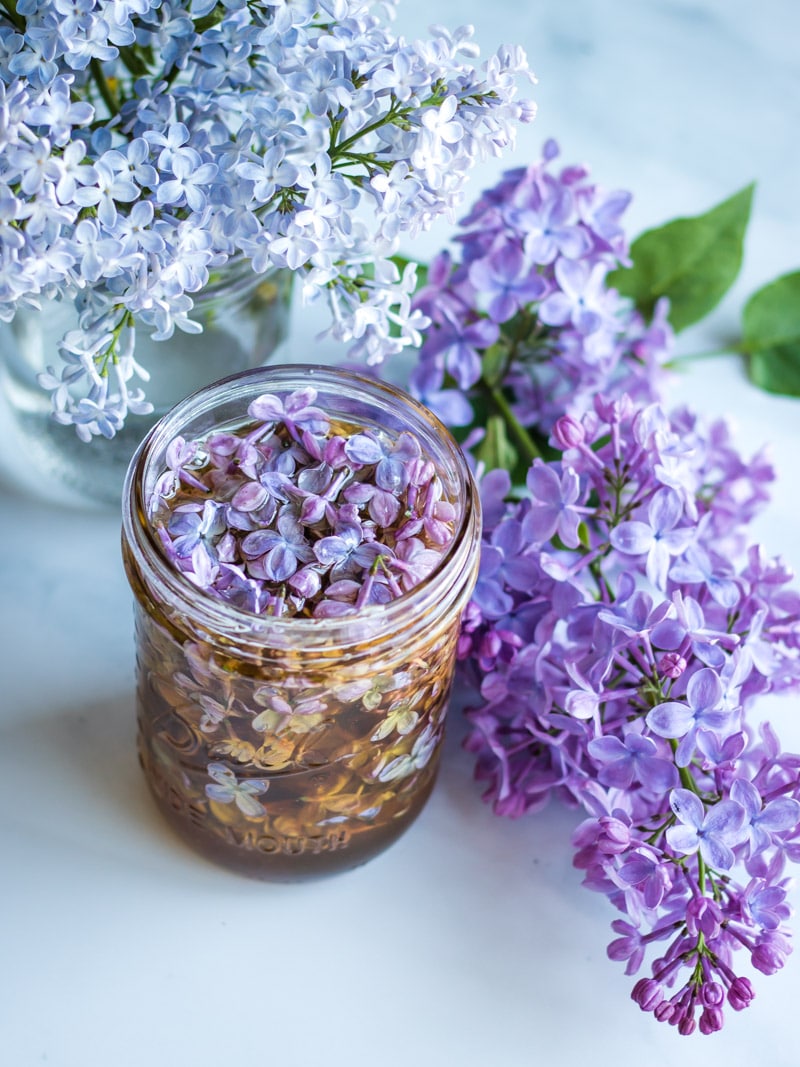

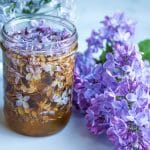

So far I have used garlic and ginger in honey, it never occurred to me to use flower as well, because in the city where I live it is not common. Thanks to the old recipe with honey, yours opens many new medicinal recipes with many other herbal species. Now we can enjoy honey even more with new flavors and aromas. Thank you!
Hi Nenad! I’m so happy you’re enjoying creating all kinds of herbal honey recipes!
Can I use dried flowers?
Without the moisture content in the flowers, the honey will not ferment, however, you’ll make one tasty infused honey that way!
Do you have ideas on how to use the flowers after you remove them?? I’m thinking of making a dessert of some kind
I haven’t reused them, but I’m sure they’d be delicious in some kind of baked good. I have a recipe for elderflower muffins that you could use with lilacs.
Hi, do you refrigerate after mixing the flowers and the honey? Or keep it out at room temp? Thank you excited to try!
Honey requires no refrigeration and can sit at room temperature indefinitely.
Can you use dried lilac and other flowers? If so, how much do you suggest?
I haven’t tried, but it should work. Dried herbs have a more concentrated flavor, so I would start with half of the recipe’s listed amount and adjust if the flavor isn’t strong enough.
Can you use white lilacs?
Hi Michelle! Yes, you can!
Thank you. Today I was driving with lilacs in the car. I just wanted that scent to last forever… now I can capture it for the year.
I wanted to try this recipe but with wild plum blossoms as they are in full bloom here! Would this work with plum blossoms even though they are a bit more delicate?
Awesome recipe! I will have to try it!
great article, and lilacs smell So lovely. I will make it when the weather is a little warmer. Thankyou….
I have been using honey infused herbs as medicine for children for some time. Takes the anxiety and upset out of taking medicine when the child is sick…garlic honey, sage honey ,comfrey & pansy and juniper honey are the ones i use most often with good results. For the stomach upsets children tend to be prone to after a little friends birthday party, or extra treats from grandma…or simply too much of a good thing…like pizza..a little activated charcoal mixed into a spoon of pansy honey is an effective and rapid solution. I would offer small suggestions i have found helpful….The darker the honey the more mineralsl it contains…and…the less likely it is to candy. However if a lighter colored honey does go candy, don’t heat it directly…Rather, a double boiler at low heat will liquify it in no time. Secondly, leaving the infusing flower/herb honey on a sunny window sill or patio is important…rather than a dark cupboard. The sun draws the goodness from the plants and into the honey. And must be over 160 to destroy enzymes in honey…so sunshine is fine. Lastly, rather than stirring the honey daily, I simply invert the jar once a day….ie upright one day….on its lid the next day…upright the following day.and so on. Ensuring the herbs are thoroughly infused throughout. Do ensure your lid fits very tightly, so there are no spills. Lastly..be aware that a worker bee only makes 1/12th of a teaspoon of honey in his entire working life. So use sparingly, and with respect
Thank you so much❤️🙏
I also appreciate spreading respect and love for the honeybee🙌
Good info. Thanks!
Can the botulism producing organism live in honey? Typically one wouldn’t use a non-dried herb in a non-oxygenated medium for long-term storage for that concern. I learned that when I was exploring herbal infused oil dressings. Since, I have always been much more concerned for some of my creative productions. Sorry to be a “downer” on this wonderful idea.
Hi Louise, good question. Honey usually has an acidic enough pH that botulism really isn’t a concern! It’s much different than fresh herbs in oil where some kind of acid needs to be added. If you are worried you could add a splash of vinegar or lemon juice to it, but I don’t really think it’s necessary in this case.
My raw, unpasteurized honey is rather solid. Should I heat it a bit to get a more liquid state? I can’t even pour it, so I’m concerned about how to mix in the lilac flowers? Thanks!
Yes, gently warming it to a liquid state should help!
What are the benefits of infusing lavender?
Firstly, it’s delicious! Second, it has some medicinal benefits such as being calming and antibacterial.
This looks and sounds delicious. I have never thought of putting flowers directly into honey before. Thanks for sharing